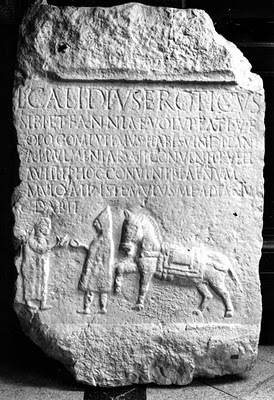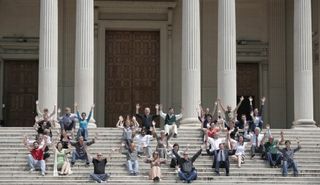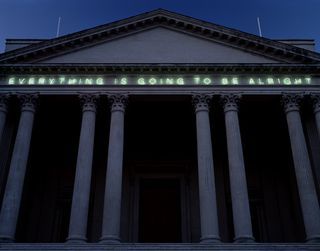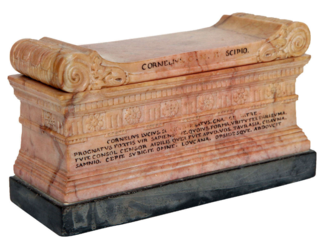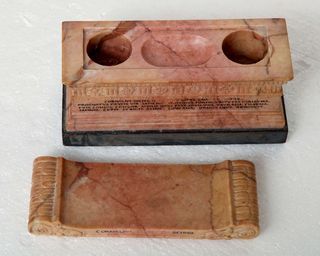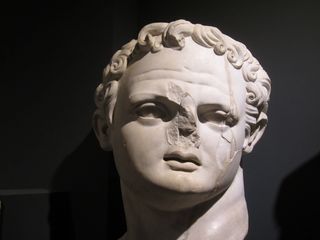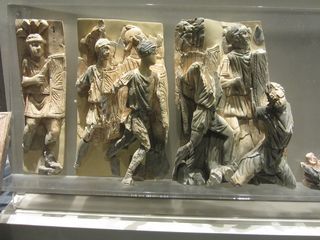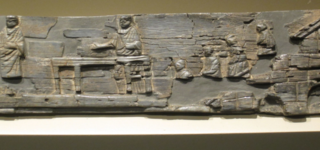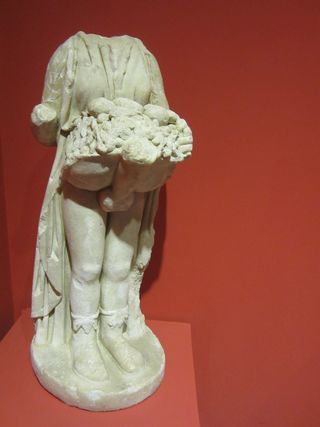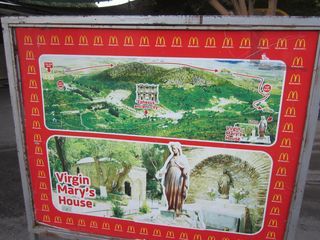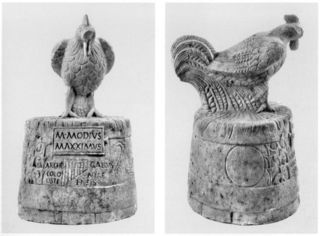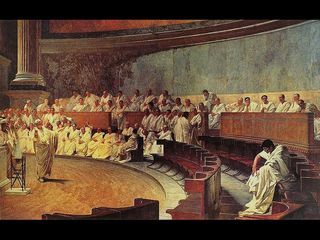Mary Beard's Blog, page 20
October 9, 2015
Fannia falanghina
Another of my favourite Roman inscriptions, which I have mentioned before and talked about at Bard, is what may be the tombstone of a couple, known for business purposes (one presumes) as Calidius Eroticus and Fannia Voluptas. All those names are individually well attested at Rome, but together they roughly equal Mr Hot Sex and Mrs Gorgeous (though Fannia in Latin does not mean what you might imagine). So it seems highly unlikely that they were the names the couple were born with, but the one���s they took to brand their bar or cheap lodging house.
And that���s rather confirmed by the little scene played out underneath the names. It���s a dialogue between an inn-keeper (Calidius?) and a customer who is asking to settle up his bill. The inn-keeper goes through everything his client has had��� bread, dips etc. Then he comes to the 8 asses for ���the girl��� (an as was pretty much the ancient equivalent of a penny), and hay for the mule at 2 asses. ���Blimey���, says the customer, ���that mule will be the ruin of me���.
I say it MAY have been an epitaph. Because although it has one or two of the formulae you might expect in a Roman epitaph (such as the abbreviation ���v f��� ��� vivi fecerunt, ���they put this up for themselves while still alive���), it is hard to quash the sneaking suspicion that this might be a pub sign, masquerading as an epitaph. Mr Hot Sex and Mrs Gorgeous knew enough about the way non elite Roman epitaphs played on the occupation of the deceased, to reverse the equation and make an occupational advert pretend to be an epitaph.
But it was only in doing the work for Bard that I discovered more about the surprising afterlife of this stone.
It was found around 1600 in Isernia in south central Italy, where it remained (with some celebrity), even though changing hands several times, until it was acquired by the Louvre in 1901 ��� and where it is still residing, sadly not on display.
But the local celebrity remains. By some avid googling I have discovered a local winery, Campi Valerio, that has taken over the name Fannia for a very good Falanghina, and use the name Calidius for their matching rosso (it���s the picture above). And on the label you will see the inscription itself, still doing its job as a logo.
There is something wonderfully touching that 2000 years later this pair of rogues (as I imagine they were) should have given their names and their image to they local vintage. Recommended!
October 3, 2015
In praise of . . . the British School at Rome
I have now officially started on my Leverhulme 'Twelve Caesars' research leave, and I have begun to plan where I am going to need to visit, to run to ground some of the more material that I will need, both in the shape of primary images and research libraries. I have already got a trip in my head to a number of local French art galleries, and I know that I need to understand the German and Austrian material better than I currently do. But it's also obvious that I shall need to go back to Italy and especially to Rome.
In recent years, for various research projects, I have had wonderful hospitality both from the American Academy in Rome and from the British School in Rome. But I fell to reflecting, as I was planning ahead, that the BSR was really where I started my research career. That is to say that, when I was a PhD student in Cambridge almost 40 years ago now, it was during four months residence in Rome that I actually discovered what research directly on Roman material in Rome was like, and how best to do it. In a way it launched my career.
The BSR is an extraordinary institution, lodged in a Lutyens building, modelled on St Pauls, that was the British pavilion in the 1911 World Exhibition in Rome (that's what's in the picture). Behind the front door it's far less formal than the portico would suggest. It's home to a group of postgraduate researchers from the UK and the Commonwealth, working in any aspect of Italian studies, from prehistory to modern art or anthropology, many on scholarships to visit; there are also a group of fine artists and architects, who have purpose-built studios. There's an amazing library for many aspects of Italian studies (no better place in the world for research on the topography of Rome), an archaeological laboratory, lecture theatre -- and a programme of events to match, from summer schools for undergraduatess to lectures and conferences and workshops. (Above is Martin Creed's light sculpture across its pediment, photo by Hugo Glendinning. I know I have used this photo before, but it is an especial favourite.)
When I went there as a raw graduate student, the whole place was an absolute eye-opener. For a start being an academic working in a community with practising artists was usefully 'destabilising', and it was one of those places where people really wanted to share expertise. When I was there the late great Martin Frederiksen was also working there, and he hoiked the little group of classicists off to lectures all over the city, and introduced to any number of senior scholars, Italian and otherwise, that we would never have dared approach ourselves. It was an amazing privilege.
I can see from the outside if you dont know the place (or any of the other British Schools in other countries), it might all seem like a strange colonial hangover. In fact many nations host research institutes in Rome, often on a more lavish scale than the British (the French live in two veritable palazzi, the American Academy is huge by comparison, the Germans likewise; but then there are also the more modest Dutch and the Belgians, the Swedes and the Danes and so on). And they host them for simple reasons. They are not only excellent places of European cultural interchange, but they really support research in a way that's needed. OK one could go and hire a room in a pensione, but even in a digital age you still need a library, preferably available 24/7 and you need academic support.
Anyway for me there seems a nice career symmetry to be contemplating going back there at the end (I hope not, but you know what I mean) of my career too. And it's nice to think of the young generation of researchers in the family using the British Schools as well. The daughter has stayed at the BSR when working on an Italian archive relevant to South Sudan, and in Nairobi I think her work would not be possible without the BSR's sister, the British Institute in East Africa.
Great and precious institutions. Long may they thrive.
October 1, 2015
Scipio Barbatus' inkwell
I have just finished my three lectures on Roman epitaphs and their afterlife at Bard College and I am moving on to a fourth and final one at the Morgan Library, New York (which is partly a reprise of the first lecture at Bard itself, though made into a self-standing lecture with a rather different focus).
I���ve had a good time, and been kept busy since I arrived late Sunday: as well as the 3 + 1 lectures (plus prep and making the PowerPoints for each, which is in the order of a three hour slog at my rate of PowerPoint progress), I���ve taken part in two undergraduate classes (on Virgil and Livy), and am just about to have ���office hours��� for students all morning before driving to New York.
I say this because people often imagine that turning up for a series of named lectures (in this case the Hecht Lectures) means just that: three performancs plus cocktail party and the rest is down time, feet up with a novel and a GandT. But there���s no point in travelling across the globe unless you are going to do a lot more than that: participate in the programme, meet students in your area, talk to them about their work, etc.
So that���s been my week, and I think that the effort has paid off. The real star of the lectures has probably been Scipio Barbatus, consul 298 BC, and the founder, it seems, of the Tomb of the Scipios at the start of the Appian Way.
A few posts ago I mentioned all the replica tombs I had started to collect, close look-a-likes of Barbatus��� sarcophagus made to hold a whole range of nineteenth-century worthies. (and thanks to all commenters for suggestions and reading on that) Well, since then I have been digging out a range of Barbatus memorabilia in other forms. I am particularly curious about the replica inkwells that were obviously (to judge from those on sale now) were quite a common element in the nineteenth century Italian souvenir industry. Some are almost identical, and were presumably produced by the same workshop, but you do find a few variants, like the black marble one above.
This, by the way, is where the ink and nibs fit.
They get everywhere. One even turned up in an auction in Cambridge a couple of weeks ago. (And yes I did...if you are wondering.)
But here���s my question. Why turn this sarcophagus into an inkwell and apparently nothing else? I have seen one reference to a Scipio Barbatus matchbox but suspect that it might actually have been a misidentified inkwell. What other antiquities got turned into desk toys/utilitarian accessories not simply ���ornaments���? What gave the sarcophagus of Barbatus this very special afterlife?
September 27, 2015
Off to Cheltenham
In a couple of weeks, on 8 October I will be performing with a TLS team at the Cheltenham Literary Festival: that���s Ruth Scurr, Peter Stothard and me. It���s a panel discussion and debate about writing history ���and we mean writing and ���doing��� history as much as the end product. We���ve all, in our time, had a go at writing history in a different form, under a different rubric. But conventional or unconventional, it���s the ���how you go about it��� that we want to explore.
Readers and commenters on this blog have been very patient (and I hope interested), as I have issued regular bulletins on the state of progress, or not, on SPQR ��� from the simple issues of where and how you actually write (in my case I can go days without ever getting dressed, tapping it out on the laptop on the kitchen table) to what you do when you get stuck (I can still remember the troubles of writing Chapter 4��� which for weeks of its early existence last year I thought was fine, but just a bit dull, and it took me hours to (I hope) fix.)
I���ve always thought that writers, but academics in particular, were uncomfortably reticent about the writing that made their names. And you���ll see in many an academic memoir phrases like ���that was the summer I finished my book on Greek particles ������. Yes, I reflect, you may have finished it, but for that summer it was probably one of the most preoccupying, difficult and totally engrossing things you did. Cant you tell me a bit more than that you finished it? Cant we learn about the struggle and the fun, and where exactly you wrote and why.
Anyway those are some the questions we���re going to try to address in our discussion��� how do non-fiction writers write, through thick and thin.
So we all hope that people will come along and join in the discussion. See you there.
September 26, 2015
A wonderful museum and some very odd notices
I have just been stunned by the new museum at Ephesus, which I think only opened a few months ago, funded largely by the Austrians. I hadn���t been to Ephesus for about thirty years, and it was a flying visit back then, which certainly didn���t include the museum. I got the impression that most people going to the site now don���t take in the museum too: a big mistake. Go there if you get the chance.
It���s not simply that it is ���state-of-the-art��� in terms of modern museum display (though it is that, for 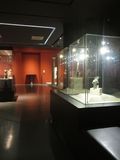 sure). The objects found in the ancient city rank with anything anywhere in the Roman world.
sure). The objects found in the ancient city rank with anything anywhere in the Roman world.
If you ask me for the highlights, I would pick out first the colossal statue of a gloriously overblown emperor Domitian ��� presumably an ���acrolithic��� statue, with marble extremities fixed onto a wooden or metal frame. The head looks grimly misformed, but would have looked far less silly from twenty feet below (as I tried to capture in the photo below). It���s a great reminder that the kind of vast, superhuman creations famous from the statue of Constantine that has long been admired in the courtyard of the Capitoline Museum in Rome were not innovations of late antiquity. There had been colossal statues in Rome as long has there had been autocrats.
Something that was quite new to me, however, was a substantial piece of ivory carving, originally made to decorate some very grand piece of furniture, or perhaps to go on a wall or lintel.
It dates from the reign of Trajan or Hadrian. Or that at least is what the very close stylistic match with Trajan���s column would suggest. The miniature military scenes on this ��� whatever exactly it was ��� are the spitting image of the much bigger scenes on the column. Underneath are some more puzzling civilian scenes, even smaller. I haven���t been able to work out, or look up, what they are yet. Any ideas?
And in one corner was a superb phallic creature, which it took me a long time to spot without my glasses; but I now see tat this headless creature is balancing a very large basket of fruit on his erect penis (shades of the famous painting at the entrance to the House of the Vettii at Pompeii, where the man is weighing his penis against a bag of money ��� a pun on penis and pendere, to weigh, maybe?
So a great place to spend a couple of hours. There were however a few rather odd notices, which both enlivened and puzzled. By the main front door of the museum was what looked like a ���leave your comments here��� box. But it was designated in English, a ���human rights application box���. Either there was another role and purpose to the museum that I had not spotted, or this was an odd translation of the Turkish (which others may be able to explain better than I can).
Even more unexpected was the notice on the site itself, which advertised a rather lengthy taxi trip to the in fact relatively easily walkable ���house of the Virgin Mary��� (she came to Ephesus in retirement). The place, as you see, now seems to be actually sponsored by McDonald���s.
But none of this beat the notice on the entry to Izmir airport. There seemed to be an odd set of priorities here. Smoking strongly forbidden (well I understand that). But just please take the guns you might happen to be carrying, as you do, to the "delivery desk���? It was carefully repeated at check-in.
September 19, 2015
Marcus Modius Maxximus and the art of commemoration
I am in the process of finishing the three lectures on Roman memorials and epitaphs that I am doing for Bard College in a couple of weeks. The first one is done and dusted, and focuses on the Tomb of the Scipios, its history both ancient and modern. After a few weeks of obsessive delving, I have found some rather extraordinary and unexpected things about the modern side of this, which I shall soon reveal (Bard must have it first ��� but I have to confess I am feeling full of nerdish pleasure about it).
The second one I am writing now, and it is really concentrating on the way that Roman epitaphs can take us into the cultural world of the non-elite in the Roman empire. And that includes the visual puns and jokes that a striking number of these memorial lines and images traded on. The lecture���s picking up, and drawing together, some topics I���ve been interested in for a long time.
Several years ago I did a lot of work on a strange epitaph of a castrated priest ��� a gallus -- of the goddess Magna Mater (Cybele); it was originally from Ostia and is now in the Vatican, not all that far from the sarcophagus of Scipio Barbatus, in fact. It was the first time I saw quite how clever these ���ordinary��� Roman epitaphs could be. The man���s name was Marcus Modius Maximus (or Maxximus as he spelled it), and he was described on his memorial stone as the ���archigallus���, the ���chief priest��� of Magna Mater. But he, or his commemorators, had written his name into the stone in a very different way too and it was the extraordinary form of thing that interested me most. This isn���t how most Roman epitaphs look.
It wasn���t all that hard to work out. The bottom of the strange memorial was in the shape of a Roman corn measure (or ���modius). And on the top was a splendid cockerel, that���s ���gallus��� in Latin. It was in other words a speaking stone, representing the name of the man in visual terms, or punning on the man���s name and position as ���(archi)gallus).
Without giving the game away, Lecture two takes off from there, hoping to display the linguistic cleverness of ordinary Roman commemorative practices, and Rome as a punning culture. Ovid might have had repeated fun with word play at the cutting edge of Roman elite versifying, but the fact is so did those much further ���down��� the Roman cultural foodchain.
And Lecture three? It���s how to memorialise a Roman woman.
September 17, 2015
Suppose Corbyn HAD sung the national anthem . . .?
I realise that if you want to complain about the excessive media coverage given to any topic, it���s rather counter productive to write yet another blog on it. But I am just travelling back home, armed with only yesterday���s copy of The Times for recreational reading, and I discover the whole paper is still full of (largely attacks on) Jeremy Corbyn. I suspect most of the other papers would be much the same, but I haven't seen them.
The front page has a picture of him not singing the National Anthem (���Veterans open fire after Corbyn snubs anthem���); the story continues on page 4 (pages 2 and 3 are ads, and Corbyn free for that reason only, I guess).
Pages 8-13 are pure Corbyn attack. The first headline is ���pressure mounts on Corbyn after Labour goes to war over EU���, followed by another sexism story and some tit-tutting about him accepting the leader of the opposition���s pay rise. Then there is a rather desperate half page attack on John McDonnell (���The new shadow chancellor, John McDonnell, once edited a newspaper printed on the presses of a Trotskyite group reported to have been funded by Muammur Gaddafi��� it starts���), plus a paragraph by paragraph (largely hostile) analysis of his speech to the TUC. The picture shows Corbyn and Tom Watson (���who had almost found a jacket that fitted him���) apparently taking away sandwiches from the lunch after the Battle of Britain commemoration (���And then Jeremy went and swiped a veteran���s lunch..���).
There are three little sideswipes in the diary column, followed by a three quarter page attack by Danny Finkelstein in the op-ed. Apparently Corbyn states publicly that Hamas and Hezbollah commit acts of appalling terrorism, but also believes that wider issues of geo-politics play a part in their actions (I think that is broadly my position too, for what its worth). Another nail in the Corbyn coffin for Finkelstein.
The first leader is an attack on McDonnell. You have to get into the magazine section before you find Carol Midgley saying that Kerry McCarthy, a vegan with a commitment to improving animal welfare standards might actually be a good environment, food and rural affairs shadow minister.
To be fair, there was a splendid defence of Corbyn by Libby Purves in The Times a couple of days ago. But yesterday was almost wall to wall assassination attempts. OK I am sure there is plenty on which to disagree with him, and some of this stuff is quite funny too in the traditions of political satire (I���m not just having a sense of humour deficit). But it���s the relentlessness of it, and the personal spite, that is becoming offensive.
On the question of the national anthem (for which he even got a gratuitous ticking off from Simon Schama on the Today programme, interrupting his interesting stuff on portraiture!), I don���t know what the poor guy could have done. He is well known to have broadly Republican sympathies, though no active plans to depose HM the Queen (a position which many share). If he had lustily rang out with ���God Save the Queen���, the same papers which lambasted his ���snub��� would have been decrying his hypocrisy. A dignified silence probably seemed the best option. There are many ways to demonstrate patriotism, you know, guys���. That ���s what liberal democratic pluralism is about.
If I were a conspiracy theorist, I would now be suspecting that in the bowels of Fleet Street there was a clever idea going the rounds that unadulterated attacks on Mr Corbyn would gradually bring the British people round to his side in sympathy (for surely he can���t be that bad). But I doubt it.
September 13, 2015
Democratic decisions -- or give Corbyn a chance
I am amazed by the reaction of almost all newspapers and some big Labour shots to the Corbyn victory. The guy gets a good majority across all sections of the Labour party electorate (not just the Johnny come lately's), he gives a broadly based acceptance speech, he accepts differences of view within the Party -- and then within hours of the result a big chunk of the Labour front bench has resigned (giving everyone the chance to say that Labour was in civil war), Cameron has predicted a national security disaster, and almost every commenter -- even those who just a few weeks ago was applauding plucky Mr Tsipras with policies far more 'radical' than Mr Corbyn -- is predicting a return to the nightmare 70s (or was it 80s -- an era. anyway, that many dont remember).
I still havent entirely made my mind up about Jez. But, put it this way, much of what he would like to do (eg renationalising the rail network) is something I feel broadly sympathetic to, and I like the sense that there might be a space for different views (I've had enough of parties in which everyone agrees about everything). But more important is the sense that New Labour (now I guess Old Labour) just doesnt get it. It's not just the "core vote" (whatever that is) that hates with a vengeance the prepared slogans, the toe-ing the party line, the unwillingness to break ranks on anything that is 'party policy' even though we all KNOW it is not what they think. It's the rest of us who are looking for someone to talk to us without looking at the autocue.
Corbyn, I reflected, may be unelectable. But so -- excellent as they are in many ways -- are Burnham, Cooper and Kendall. So maybe the best idea is to give Corbyn some space and see what happens. And maybe Cameron should pipe down about him being a threat to national security (talking to the "enemy" has NEVER been a threat to national security and indeed has usually enhanced it). And Mr Gove might reconsider his own strident words. To be fair, Gove is himself very generous about Corbyn's humanity. It's the supporters he worries about.
there are some people who want to bring protest onto the street. I think it���s important that we keep our politics civilised - See more at: https://www.politicshome.com/party-po...
there are some people who want to bring protest onto the street. I think it���s important that we keep our politics civilised - See more at: https://www.politicshome.com/party-po...
"I do worry ... that there are some people who want to bring protest onto the street. I think it's important that we keep our politics civilised".
Since whan was peaceful demonstration NOT civilised? Basic democratic right, eh?
September 10, 2015
Cicero and the drones
I have come to think that the issues raised by Cicero's conflict with Catiline in 63 BCE are not likely to go away for some time to come (which is actually why I started SPQR with it). Cicero the consul of Rome, believing that Catiline was behind a terrorist plot, backed by a makeshift army, to destroy the city, rounded up some of the main suspects and executed them without trial. He repeatedly dubbed them 'hostes' or "(foreign) enemies", and so casting as them as men who had forfeited their citizenly rights to due legal process. His view did not prevail. In a campaign led by a personal enemy, he was exiled for flouting the civil liberties of Roman citizens, and his house destroyed -- and a shrine of Liberty erected on the site.
It still remains unclear whether Cicero was conveniently discovering 'reds under the bed', or whether Rome was really in mortal danger. But for ever after it has been the classic case of the clash between the rule of law and civic rights on the one hand, and on the other the obligation of the civic leader to ensure homeland security.
And that, I suppose, is the nub of the problem of Cameron and the drones. I dont want to oversimplify. My own view about shooting British citizens without trial and remotely, when their presumed unfulfilled crimes are in the past, are no doubt predictable. But, whatever I think about Cameron et al., I dont imagine that the prime minister or anyone else took the decision to kill the 'suspects' in any way lightly, or without realising what the implications are.
All the same, the issues of security vs civil liberties that the drone attack raises are much the same as those that Cicero faced. So it was curious to hear defence secretary Michael Fallon, a trained classicist, speak up for the goverment's line in getting rid of "hostes". I hope that he had not forgotten the Catiline moment.
September 5, 2015
Soft power
I realise that it is hardly likely to come as a surprise that I am a paid up supporter of a BBC supported by the licence fee -- or by some modified version of it that would deliver appropriately generous public funding. And I applauded what Armando Ianucci had to say in his lecture the other week: if a private business was as successful as the BBC, it would be congratulated, not criticised for over-reaching or becoming bloated.
OK, you might say, I wouldn���t bite the hand that feeds me, would I? I can only reply that if you wanted to buy a yacht, making documentaries on the Romans wouldn���t be a sensible way to fund it. True there is decent compensation for the time, but it���s not the money that���s the reason for doing it.
I guess I am one of those who simply fails to understand why any government (even those who deny it) would want to unpick the basic rationale of the BBC as a public service broadcaster. Anyone who whinges about it should try a few months in the USA and see what the commercialised world of tv and radio is really like (with some plucky but underfunded bits of PBS on the margins). The idea of never being able to watch anything without an ad break every 15 minutes is not a happy one-- and even PBS radio is interrupted by regular appeals for the listeners/viewers to give money to keep the station on air.
But it is very striking to listen to what people abroad say about the BBC. Over the last few months I have been filming a new Roman history documentary, often on public archaeological sites in a number of different countries in what was the Roman empire. What is striking is how often people come up -- from as far afield as Ukraine and Australia -- who have watched and enjoyed our earlier BBC series and are keen to say so. And when, to others, we politely ask if we could have a little space to film, and they say 'who are you filming for?' and we reply 'the BBC', they almost say 'oh the BBC, yes of course'.
Now I realise there may be some preselection here. BBC haters are more likely to turn away and huff and puff than to engage in an argument about the vices of the corporation. But is still leaves you thinking that the BBC is one of the (few?) UK institutions that commands favour and respect overseas. Of course it does, try Italian tv!
So why wreck it?
Mary Beard's Blog
- Mary Beard's profile
- 4110 followers



